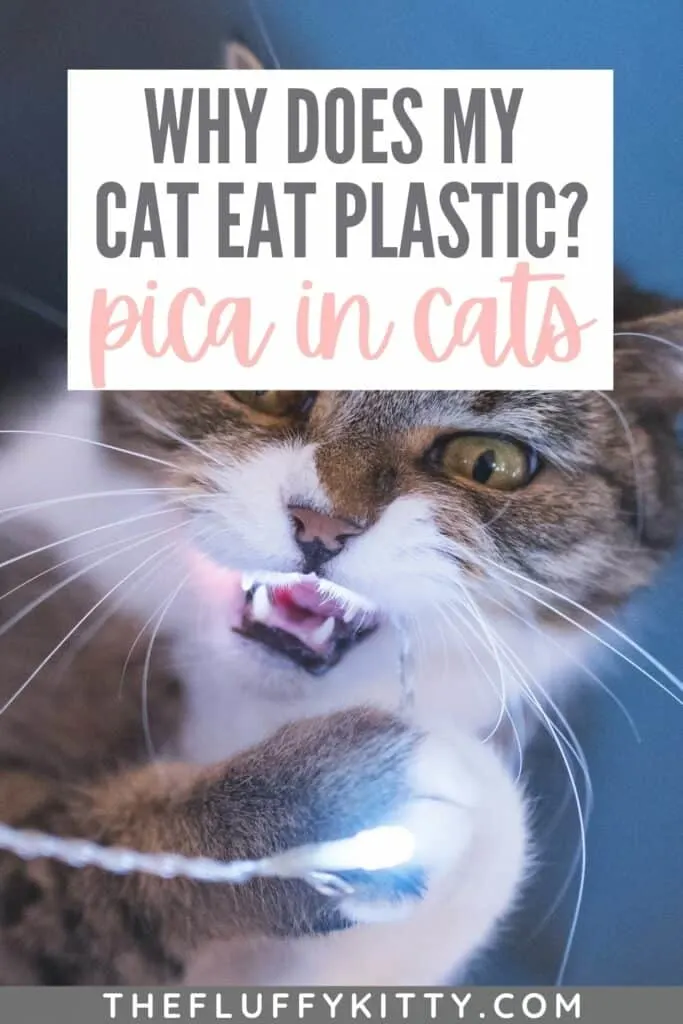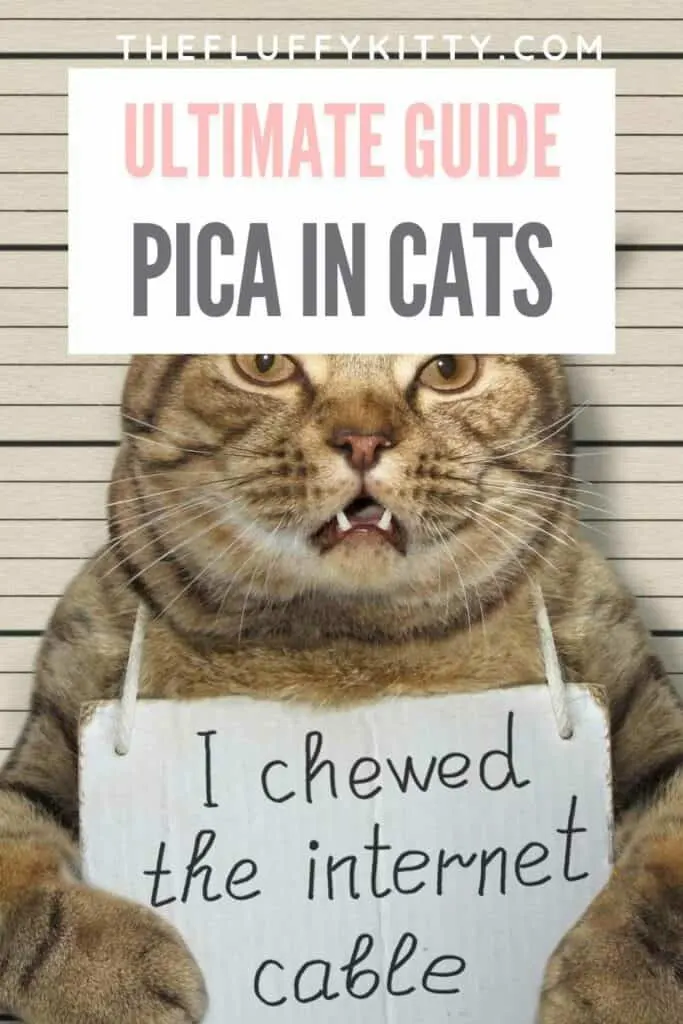“Why does my cat eat everything?”
If you’ve ever walked in to find your kitty munching on something bizarre, yet again, this question might have popped up for you.
Whether you find your cat chewing your shoelaces, your shower curtains or even your electrical cords – it can be an unsettling and worrying experience for us pet parents.
But by far the biggest question we see floating around the cat community is why is my cat eating plastic? Tupperware, grocery bags, or any other plastic goodies…whatever they can get their paws on, our kitties seem totally fixated with the stuff.
The answer? Pica.
Described by researchers as “the ingestion of inedible items”, this condition can affect cows, birds, dogs and even humans too! But it’s estimated that around 40% of cats will be affected in their lifetime – which is a huge number of our beloved felines.
As the saying goes, knowledge is power. So we’ve compiled here the latest research and findings, to help shed some light on this issue for worried fur parents. We’ll be diving into:
- What is feline pica?
- Ingesting non-nutritional items
- What causes pica in cats?
- The possible genetic, behavioral and environmental causes
- The signs and symptoms of feline pica
- Including the common materials cats reach for
- Possible treatment options
- Medical treatments, stress management, environmental enrichment ideas & supplement suggestions
- The best chew toys for cats with pica
While a little playful chewing is normal, pica is potentially dangerous for our fur babies, specifically because what they end up eating really isn’t good for them! This is why it’s important to understand what drives our kitties to chew.
Because the more we know, the better we can care for our beloved fluff balls, right? So let’s get started!
Pica in Cats – Symptoms And Treatment
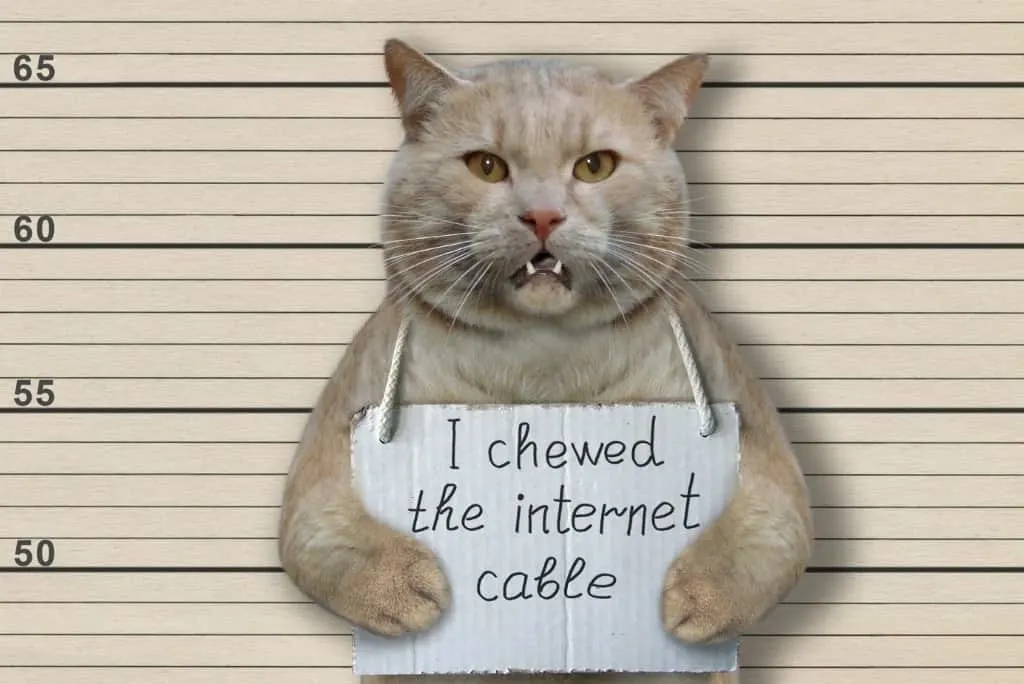
What Is Feline Pica?
Pica is categorized scientifically as “the compulsive eating of non-nutritive substances”.
What this means is that an animal suffering from pica has the desire and drive to eat items that are not providing them with any nutritional or health benefits.
Unlike eating grass, which some cats may be doing to help them with any stomach issues, pica sufferers will usually be drawn to chewing anything – even things that could cause them to get really sick.
Did you know?
The name pica comes from the Latin word for magpie – as these birds are renowned for their unusual ability and willingness to eat pretty much anything.
What Causes Pica in Cats?
There are a few things that could be causing your kitty’s chewing habits.
- Breed – do you have a gorgeous Siamese or Birman? Did you know that these breeds are more prone to pica than others.
- Age – pica is most likely to affect your kitty during the first 4 years of their life, usually between 6 to 18 months. This means it could be linked to your furball reaching maturity (those pesky hormones!) and their first feelings of territorial behavior. Interestingly though, neutering seems to have little effect on the symptoms.
- Rehoming – according to researchers, pica is most likely to affect your cat in the 2 months after they are rehomed. It’s often linked to the stress of being in a new place and to the possible emotional effects of a kitten’s separation from their littermates. Which makes a lot of sense, right? Those are scary things for our fur babies!
- Early weaning – on a similar note, other research has found that weaning kittens early can lead to a higher chance of them developing pica.
Other possible causes that scientists have found include:
- Boredom
- Lack of social contact
- Redirected hunting behavior
- Fibre deficiency
- Obsessive compulsive disorder
- Abnormally large appetite
- Diabetes
- Nutritional deficiencies
- Other chronic medical conditions
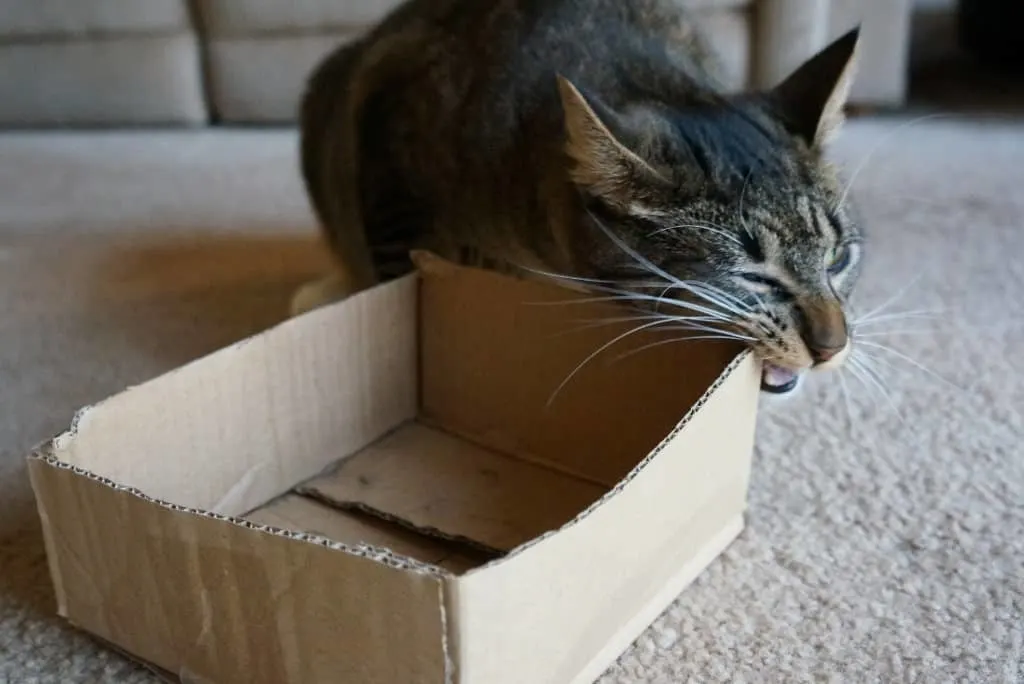
What’s Beneath It All?
Such a huge range of possible causes can be hard to digest…literally! This is why many researchers are now trying to look at what could be the root, root cause.
Did you ever suck your thumb as a child? Or did you have that special comfort blanket or toy you loved to put in your mouth as a toddler?
Chewing or sucking on objects in animals is now believed to be similar to this human behavior. Thumb sucking releases feel good hormones and reduces tension in humans. So it’s not such a stretch to think that our cats are seeking that warm feeling of well-being and comfort.
But problems happen when this behavior becomes an addiction, rather than a cute kitten activity.
So how can you tell if your cat is suffering from pica rather than just going through a phase, or just playing?
What Are the Signs of Pica in Cats?
Many young kitties will chew or tear apart cardboard, toys or other items while they are having a crazy play session (yes that’s you, Yoda!). This is totally normal predatory behavior.
What’s different about a pica sufferer is that they will tend to obsessively chew, suck or grind the object along their back teeth and then sometimes swallow.
This kind of constant focus on chewing, eating and sucking is the biggest symptom of pica, and many cats will go to serious lengths to get their paws on something they want in their mouth!
In a British study, the most common materials sought out by cats with chronic pica included:
- Wool
- Cotton
- Rubber
- Paper
- Man made materials (like electrical wires and shower curtains)
- Cardboard
- And of course plastic!
Other symptoms can include:
- Your kitty having low energy or seeming fatigued
- A reduced appetite
- Constipation
- Diarrhea
- Vomiting
Obviously, cats eating items they aren’t supposed to can be risky for their health. Pica sufferers are more likely to experience intestinal blockages, poisoning, nutritional deficiency, and (if they aren’t careful) electrocution.
So how can you help keep your kitty safe?
Treatment for Pica in Cats
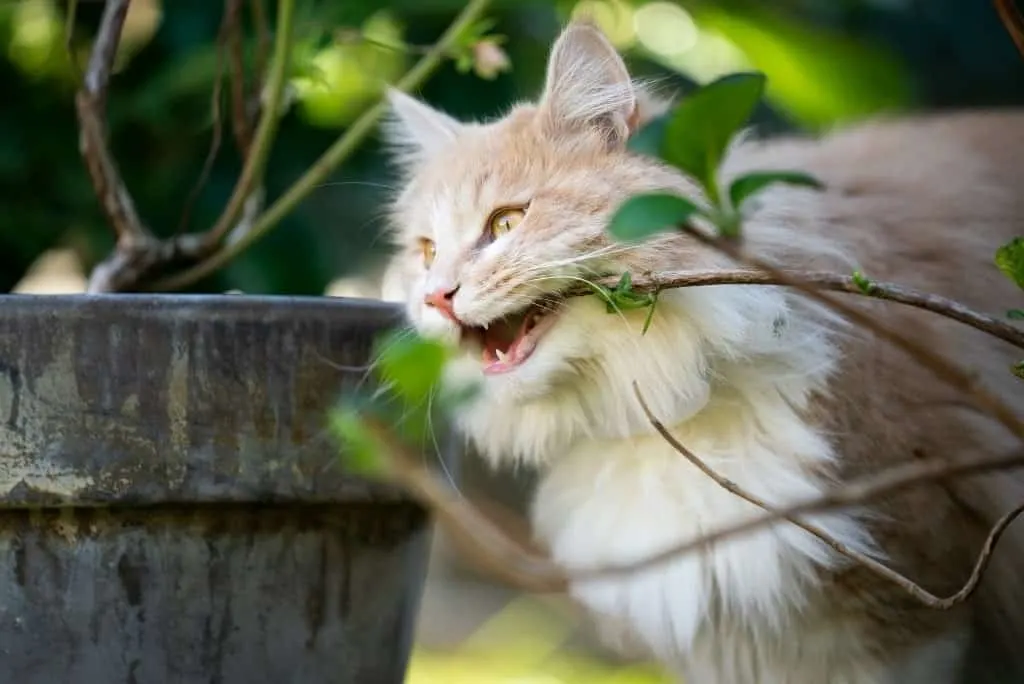
1. Visit Your Vet
As pica can sometimes be a symptom of other medical conditions, your first step should be to visit your vet to get a proper diagnosis.
If you can, bring along any notes of how the behavior looks on a daily basis, what your kitty is seeking out to eat and when the behavior started.
For example, did it start when you moved apartments? Did your schedule or household change? Or does it seem to be totally random? Any information you can give your vet will help them find the possible cause.
If they want to rule out any medical causes, your vet may then conduct blood tests, a urinalysis and perhaps a CT scan too.
2. Check Their Nutrition
If no underlying medical cause is found by your vet, be sure to discuss your cat’s nutrition with them.
Felines are super clever, and if they sense a deficiency they will try and find it somewhere else! Your veterinarian may suggest some vitamin supplements, added fiber or an alternative food to try.
3. Controlling the Environment
To keep your kitty safe, try and remove all their triggering items from within paws reach!
Keep socks, plastics and other tempting items in cupboards or secure boxes. If you can, try and supervise your fur baby as much as possible – as we all know how clever our feline pals really are at getting what they want!
If you see your cat get their paws on something they shouldn’t, try to redirect them with some food, a toy or a treat. Once distracted, remove the item from their reach as soon as you can.
4. Keep Them Busy
One way to reduce any kind of behavioral problem is to make your cat’s world more exciting. This way they are simply too busy to think about getting their paws on your socks!
If you have an indoor cat, invest in some enriching toys to play with together, and a super cool cat tree for them to watch the world go by in.
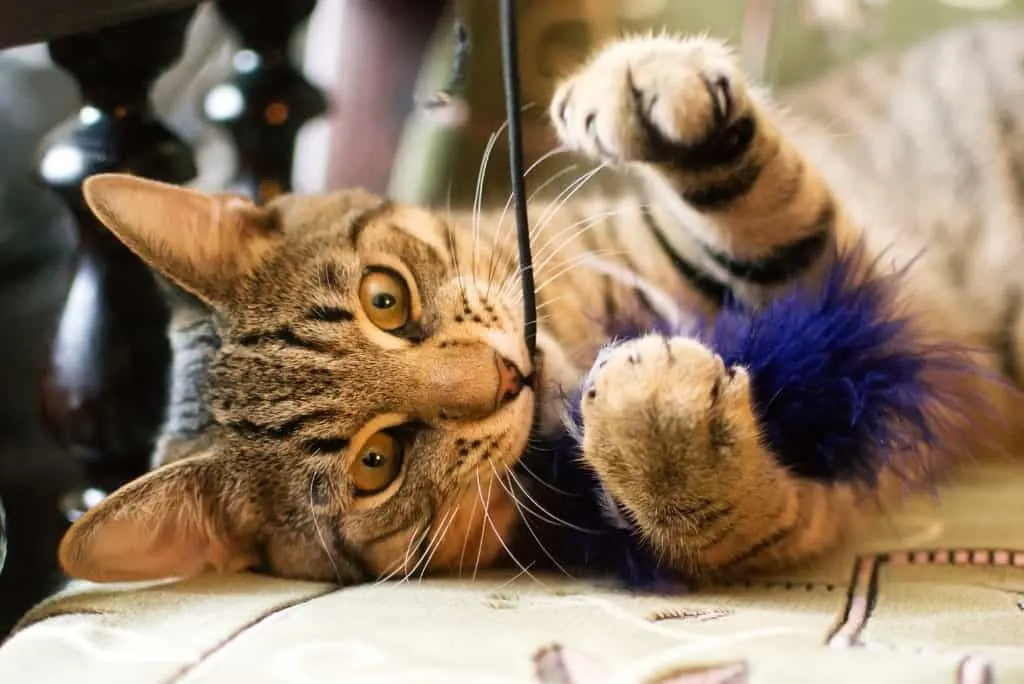
Better yet, why not try training them to walk on a leash so that you can both experience some safe outdoor adventures together?
Or get your DIY on and construct a “catio” for your fur baby. You can even use Ikea furniture to create these outdoor play areas or be inspired by this awesome tutorial.
5. Manage Stress
If you are pretty convinced stress is causing your cat’s pica, then try to identify the specific triggers.
For example, if your cats are fighting, try separating them.
If it’s a new schedule or environment, can you find a way to ease your cat in, perhaps by taking a week off and slowly helping them adjust?
We’ve also got a list of the best natural remedies for calming cats, which we highly recommend for pet parents who want to bring some zen back into their paw-pal’s life.
6. Chew Toys for Cats With Pica
One great way to help curb the urge to find those shoelaces is to offer some safe chew toys instead. Here are our top picks:
- The Kitty KONG Cat Toy – a 2 in 1 toy and treat dispenser, which is sure to keep your feline occupied. Kong toys are renowned for their durability, and as it’s made from a rubbery material it’s great for satisfying that urge to chew.
- Yeowww! Catnip Yellow Banana Cat Toy – this toy is made in the USA from super durable cotton twill. Reinforced with extra strong stitching, it’s protected from tearing or being eaten up. In fact, some pet parents are saying their toy is still going strong after a year of chewing! Stuffed with 100% organic catnip, it’s also made with all-natural fabric dye derived from vegetables, making it safe for your cat to spend a happy few hours chomping away.
- SnugglyCat Ripple Rug Cat Activity Play Mat – made for hunting, hiding and all kinds of fun, this ripple mat is designed to keep your kitty fully occupied. Crafted from durable carpet-like fibers that have a “non-fray technology”, it’s non-toxic and likely to stand up to some serious chewing. Plus it’s made from recycled plastic bottles too!
- Natural Wood Cat Teaser Wand – teaser wands are an amazing way to get your cat engaged and moving. Plus, as it’s an interactive play toy meaning you are in control of how long your cat is able to chew. Plus, the toys and wand are crafted from natural materials like wood and sial, which are better for the planet too.
As with all toys, but especially cats with pica, be sure to supervise their playtime. With such sharp teeth, rips and tears do happen!
7. Anxiety Supplements
As anxiety is often the root of many pica cases, anything you can do to help calm your cat will be really useful.
Some animal behavior experts suggest that the following ingredients can help to manage anxiety in our furry pals:
- L-theanine – this is a special substance found in green tea. It’s believed to potentially help boost a kitty’s serotonin levels and help them feel more relaxed by boosting alpha brain waves. Wow!
- Magnolia officinalis extract – this is believed to help provide pets with a sense of calm, especially if they are worried by loud noises.
- Whey protein concentrate – specifically the kind with alpha-lactalbumin in (before you go sharing your gym shake with your feline pal!) This essential amino acid helps to balance out that all important nervous system. Studies in cats showed adding a little to their daily diet decreased anxious behaviors – amazing!
Speak to your vet and see if they recommend any cat-specific supplements that contain elements of the above or take a look at these natural calming remedies for cats.
Final Thoughts – Cats Living With Pica
While we still have a lot to learn about pica and its causes in our cats, we hope that this toolkit of management options can provide you with some proactive ways to help your kitty live a happy, healthy life.
Do your furballs have pica? How do you manage their condition? What top tips would you share with this community? We’d love to know!
PIN THIS FOR LATER!

